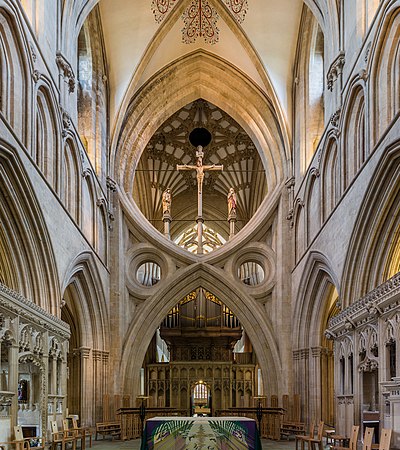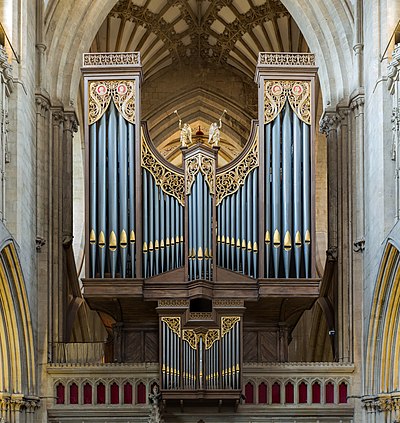Talk:Wells Cathedral/Archive 3
| This is an archive of past discussions. Do not edit the contents of this page. If you wish to start a new discussion or revive an old one, please do so on the current talk page. |
| Archive 1 | Archive 2 | Archive 3 |
Possible serious error
At 11:02 am New York time 29th Nov 2020 this article contains the sentence "Strainer arches, sometimes described as scissor arches, were inserted by master mason William Joy to brace and stabilise the piers as a unit." If you google for images of scissors-arches and images of strainer-arches, you will find they are NOT the same thing (although Salisbury Cathedral has both). A scissors-arch is as it is in this article, an arch topped by its own reflection. A strainer-arch has its curved sides filled in to a level even with the uppermost point of the arch, and then, on top of that straight line, more material is added, usually heavily pierced in the manner of strainer (not that I am asserting that that is the source of the name, for I don't actually KNOW that, despite its being a reasonable surmise). Both treatments are devised because the weight-bearing capability would be insufficient without the modifications/additions.2604:2000:1383:8B0B:1C64:8308:33BC:E2D6 (talk) 16:07, 28 November 2020 (UTC)Christopher L. Simpson
Citations to Harvey's books
I think something is amiss with the citations to Harvey's two books. I have Harvey 1987 (the 2nd ed.) before me, but page 19 does not mention Wells as the reference in the lead suggests. Neither in the places that Wells is mentioned is the information referred to explicitly described. (Although the entry on the anonymous "Master of Wells" implies it with phrases like "earlier than anything in France".) I think some of these citations might be in error and should refer instead to his English Cathedrals (also cited), which I have yet to get access to but which snippets on Google Books suggests does deal with Wells in the context of the "earliest Gothic cathedral" question and describes early-12th-century Romanesque–Gothic transition buildings in England and elsewhere before Saint-Denis in the 1140s. GPinkerton (talk) 14:06, 4 December 2020 (UTC)
I stumbled on a photo from 1927 in old family photos
Believed to be taken by my grandparents.

— Preceding unsigned comment added by Ajoiner (talk • contribs) 14:57, 24 March 2022 (UTC)
Featured picture scheduled for POTD
Hello! This is to let editors know that File:Wells Cathedral Arches, Somerset, UK - Diliff.jpg, a featured picture used in this article, has been selected as the English Wikipedia's picture of the day (POTD) for June 22, 2022. A preview of the POTD is displayed below and can be edited at Template:POTD/2022-06-22. For the greater benefit of readers, any potential improvements or maintenance that could benefit the quality of this article should be done before its scheduled appearance on the Main Page. If you have any concerns, please place a message at Wikipedia talk:Picture of the day. Thank you! Adam Cuerden (talk)Has about 7.8% of all FPs 14:54, 23 May 2022 (UTC)

|
Wells Cathedral is an Anglican cathedral in Wells, Somerset, commenced around 1175 on the site of a late-Roman mausoleum and an 8th-century abbey church. The cathedral has been described by the architectural historian John Harvey as Europe's first truly Gothic structure, lacking the Romanesque work that survives in many other cathedrals. It is the seat of the bishop of Bath and Wells. This photograph depicts the St Andrew's Cross arches under the tower, viewed from the nave. Photograph credit: David Iliff
Recently featured:
|
Featured picture scheduled for POTD
Hello! This is to let editors know that File:Wells_Cathedral_Stairs_to_Chapter_House,_Somerset,_UK_-_Diliff.jpg, a featured picture used in this article, has been selected as the English Wikipedia's picture of the day (POTD) for July 22, 2022. A preview of the POTD is displayed below and can be edited at Template:POTD/2022-07-22. For the greater benefit of readers, any potential improvements or maintenance that could benefit the quality of this article should be done before its scheduled appearance on the Main Page. If you have any concerns, please place a message at Wikipedia talk:Picture of the day. Thank you! Adam Cuerden (talk)Has about 7.8% of all FPs 14:54, 23 May 2022 (UTC)

|
Wells Cathedral is an Anglican cathedral in Wells, Somerset, commenced around 1175 on the site of a late-Roman mausoleum and an 8th-century abbey church. The cathedral has been described by the historian John Harvey as Europe's first truly Gothic structure, lacking the Romanesque work that survives in many other cathedrals. It is the seat of the bishop of Bath and Wells. This photograph shows the stairs leading from the north transept to the chapter house. Photograph credit: David Iliff
Recently featured:
|
Featured picture scheduled for POTD
Hello! This is to let editors know that File:Wells Cathedral Organ, Somerset, UK - Diliff.jpg, a featured picture used in this article, has been selected as the English Wikipedia's picture of the day (POTD) for August 22, 2022. A preview of the POTD is displayed below and can be edited at Template:POTD/2022-08-22. For the greater benefit of readers, any potential improvements or maintenance that could benefit the quality of this article should be done before its scheduled appearance on the Main Page. If you have any concerns, please place a message at Wikipedia talk:Picture of the day. Thank you! Adam Cuerden (talk)Has about 7.8% of all FPs 14:54, 23 May 2022 (UTC)

|
Wells Cathedral is a Church of England cathedral in Wells, Somerset. Construction commenced around 1175 on the site of a late-Roman mausoleum and an 8th-century abbey church. The cathedral has been described by the historian John Harvey as Europe's first truly Gothic structure, lacking the Romanesque work that survives in many other cathedrals. It is the seat of the bishop of Bath and Wells. This photograph depicts Wells Cathedral's organ, built from 1909 to 1910 by Harrison & Harrison of Durham with parts retained from the old organ that dated to the 17th century. Photograph credit: David Iliff
Recently featured:
|
Oratorio Society
The Oratorio Society section of this article names Matthew Owens as its director, but in another section it is noted that Wells Cathedral's current Organist and Master of the Choristers is Jeremy Cole. It's clear that the Oratorio Society section of the article needs a bit of an update even if Matthew Owens is still directing the group, but perhaps the paragraph could also be re-worded so that it doesn't require updating every time. I suppose it depends on whether it's always the current Organist and Master of the Choristers who directs the Oratorio Society, or if the two posts are sometimes held separately. TooManyFingers (talk) 16:53, 22 June 2022 (UTC)
